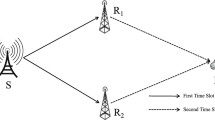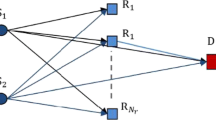Abstract
While the Network Coding cooperative relaying (NC-relaying) has the merit of high spectral efficiency, Superposition Coding relaying (SC-relaying) has the merit of high throughput. In this paper, a novel concept, coded cooperative relaying, is presented, which is a unified scheme of the NC-relaying and SC-relaying. For the SC-relaying strategy which can be considered one-way coded relaying scheme with multi-access channel, the close-form solution of the outage probabilities of the basic signal and additional signal are obtained firstly. Secondly, the Diversity-and-Multiplexing Tradeoff (DMT) characteristics of basic signal and additional signal are investigated entirely as well as the optimal close-form solutions. The compared numerical analysis shows the evaluation error of throughput based on the close-form solution is about 0.15 nats, which is within the acceptable error range. Due to the mutual effect between the both source signals, the available maximal values of the two multiplexing gains are less than 1.
Similar content being viewed by others
References
Woon Hau Chin, Yi Qian, and Giovanni Giambene. Advances in cooperative and relay communications. Guest Editorial, IEEE Communications, 47(2009)2, 100–101.
Nosratinia, T. E. Hunter, and A. Hedayat. Cooperative communication in wireless networks. IEEE Communications Magazine, 42(2004)10, 74–80.
L. Zheng and D. N. C. Tse. Diversity and multiplexing: A fundamental tradeoff in multiple antenna channels. IEEE Transactions on Information Theory, 49(2003)5, 1073–1096.
T. M. Cover and A. A. El Gamal. Capacity theorems for the relay channel. IEEE Transactions on Information Theory, 25(1979)5, 572–584.
Host-Madsen and J. S. Zhang. Capacity bounds and power allocation for wireless relay channels. IEEE Transactions on Information Theory, 51(2005)6, 2020–2040.
J. N. Laneman, G. W. Wornell, and D. N. C. Tse. Cooperative diversity in wireless networks, efficient protocols and outage behavior. IEEE Transactions on Information Theory, 50(2004)12, 3062–3080.
T. T. Kim, G. Caire, and M. Skoglund. Decode- and-forward relaying with quantized channel state feedback: An outage exponent analysis. IEEE Transactions on Information Theory, 54(2008)10, 4548–4564.
R. Ahlswede, C. Ning, S. Y. R. Li, and R. W. Yeung. Network information flow. IEEE Transactions on Information Theory, 46(2000)4, 1204–1216.
L. Qiang, et al.. Adaptive two-way relaying and outage analysis. IEEE Transactions on Wireless Communications, 8(2009)6, 3288–3299.
T. Cover. Broadcast Channels. IEEE Transactions on Information Theory, 18(1972)1, 2–14.
Y. Liu, K. N. Lau, O. Y. Takeshita, and M. P. Fitz. Optimal rate allocation for superposition coding in quasi-static fading channels. Proceedings of 2002 IEEE International Symposium on Information Theory, Lausanne, Switzerland, 2002, 111.
M. Yuksel and E. Erkip. Broadcast strategies for the fading relay channel. Proceedings of IEEE 2004 Military Communications Conference (invited paper), Monterey, October 2004, 1060–1065.
P. Popovski and E. de Carvalho. Improving the rates in wireless relay systems through superposition coding. IEEE Transactions on Wireless Communications, 7(2008)12, 4831–4836.
D. Gunduz and E. Erkip. Source and channel coding for cooperative relaying. IEEE Transactions on Information Theory, 53(2007)10, 3454–3475.
K. Lo, S. Vishwanath, and R. W. Heath. Relay subset selection in wireless networks using partial decode- and-forward transmission. IEEE Transactions on Vehicular Technology, 58(2009)2, 692–704.
Zhiguo Ding, T. Ratnarajah, and F. N. Colin. Spectrally efficient cooperative diversity protocol for uplink wireless transmission. IET Signal Processing, 3 (2009)5, 368–380.
Chun-hung Liu and A. Arapostathis. Joint network coding and superposition coding for multi-user information exchange in wireless relaying networks. Proceedings of 2008 IEEE Global Telecommunications Conference, IEEE GLOBECOM’2008, New Orleans, LO, 2008, 1–6.
Li-chun Wang, Wei-cheng Liu, and Sau-hsuan Wu. Diversity-multiplexing tradeoff analysis of a cooperative network coding system. 2009 IEEE Sarnoff Symposium, SARNOFF’09, Princeton, NJ, 2009, 1–5.
S. Katti, H. Rahul, Wenjun Hu, D. Katabi, M. Medard, and J. Crowcroft. XORs in the air: practical wireless network coding. IEEE/ACM Transactions on Networking, 16(2008)3, 497–510.
T. E. Hunter and A. Nosratinia. Cooperation diversity through coding. Proceedings of 2002 IEEE International Symposium on Information Theory, Laussane, Switzerland, June 2002, 220.
Rui Zhang, Ying-chang Liang, Chin Choy Chai, et al.. Optimal beamforming for two-way multi-antenna relay channel with analogue network coding. IEEE Journal on Selected Areas in Communications, 27 (2009)5, 699–712.
S. Zhang, S. C. Liew, and P. P. Lam. Hot topic: physical layer network coding. Proceedings of the 12th Annual International Conference on Mobile Computing and Networking, New York, NY, USA, 2006, 358–365.
H. Yomo and P. Popovski. Opportunistic scheduling for wireless network coding. IEEE Transactions on Wireless Communications, 8(2009)6, 2766–2770.
J. H. Sorensen, R. Krigslund, P. Popovski, et al.. Physical layer network coding for FSK systems. IEEE Communications Letters, 13(2009)8, 597–599.
Shengli Zhang and Soung-chang Liew. Channel coding and decoding in a relay system operated with physical-layer network coding. IEEE Journal on Selected Areas in Communications, 27(2009)5, 788–796.
T. Koike-Akino, P. Popovski, and V. Tarokh. Optimized constellations for two-way wireless relaying with physical network coding. IEEE Journal on Selected Areas in Communications, 27(2009)5, 773–787.
Anxin Li, Yuan Yan, and H. Kayama. An enhanced denoise-and-forward relaying scheme for fading channel with low computational complexity. IEEE Signal Processing Letters, 15(2008)11, 857–860.
Author information
Authors and Affiliations
Additional information
Supported by the 973 Project of China (No. 2007CB 310607), the 863 Key Project of “Key Technologies and System for Trunk Communication Based on TD-SCDMA” of China (No. 2009AA011302), and the Open Research Fund of National Mobile Communications Research Lab, Southeast University (N200604).
Communication author: Yang Longxiang, born in 1966, male, Ph.D., Professor.
About this article
Cite this article
Jia, X., Yang, L. Diversity-and-multiplexing tradeoff and throughput of superposition coding relaying strategy. J. Electron.(China) 27, 166–176 (2010). https://doi.org/10.1007/s11767-010-0316-y
Received:
Revised:
Published:
Issue Date:
DOI: https://doi.org/10.1007/s11767-010-0316-y
Key words
- Wireless communications
- Diversity-and-Multiplexing Tradeoff (DMT)
- Cooperative relaying
- Superposition coding
- Network coding




